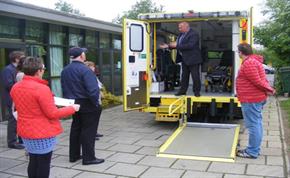
Innovations in ambulance design were the showpiece of a Suffolk community event to help the NHS learn more about improving services to patients.
Ambulance teams joined representatives from other trusts and HealthWatch to talk with residents at the special equality engagement event in Moreton Hall Community Centre, Bury St Edmunds, on Friday (25th April).
It introduced work done towards reducing health inequalities, with fleet and patient engagement staff taking on board feedback and comments made by visitors.
The day was part of the Trust’s commitment to the Equality Delivery System, and more information about that can be found here: http://www.eastamb.nhs.uk/equality-delivery-system.htm
The highlight was showing visitors ambulances which have been adapted, with EEAST being the first service to have worked with the vehicle designers directly to include the features shown. Children, for instance, can be transported more safely as there is a space where car seats can be fitted and child-friendly seat belts.
They also use air suspension to make the journey more comfortable.
From June, patients weighing up to 500kg will be able to use the tail lift and those weighing up to 300kg on the stretcher. Some of the other key features include the new design on the step that prevents a person’s foot from slipping through.
Also, the appearance of the Battenbergs is higher than the tops of cars to allow pedestrians and motorists to see the ambulances through traffic and in streets more easily.
Some changes were made in collaboration with the Guide Dog’s Association so that sight impaired patients can confidently take their guide dogs on board. The steps are also painted in a high contrast colour to enable those patients locate where the step is.
Also during the day the patient information leaflet to make it easier for people to understand how to give feedback was showcased. If you want to share this information with family and friends go to the Trust's website.
The team were asked about the capability of ambulances to convey patients in their wheelchairs or taking their wheelchairs with them, an issue which should be addressed with the next generation of ambulances.
Suzannah, who was part of the team, said: “We are very proud to have had the opportunity to engage and make a tangible difference to people in our communities”
“The feedback about the day was 100% positive. All who attended thought the ambulance design was very effective in making progress towards reducing health inequalities and the majority thought the patient services was very effective.
“We listened to lots of very helpful feedback on ways that we can further improve access to making comments and complaints about the service.”
Visitor feedback: what did they say?...
“Marvellous”
“Brilliant”
“Features in the ambulance that would normally be seen in buildings to help people with sight impairment mobilise have been utilised well to help people make sense of the environment”